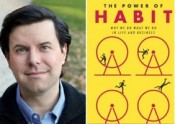Q&A: CHARLES DUHIGG – THE POWER OF HABIT
Written on May 16th, 2014 |
Aired 08/26/12
Humans are not alone in being creatures of habit, but can we do anything about it?
Brain science has learned a lot about habits over the last few years. On the one hand, that gives corporations new power with which to manipulate us, but it also gives us greater power over our own behavior.
What is a habit? Are habits positive – a sign of cultivation and industry, or negative, a sign of weakness and mindlessness? Or are they neutral, their value up to us?
Today’s guest, CHARLES DUHIGG an award-winning reporter for the New York Times, has written the best-selling THE POWER OF HABIT: Why We Do What We Do in Life and Business. He tells us that at its most basic level, a habit is a simple neurological loop: a cue (my mouth feels gross), a routine (I should brush my teeth), and a reward (ahhh, minty fresh!). Backing out of the driveway, replying to emails, running before work – many of our most basic daily actions are not, in fact, the products of well considered decision-making, but outgrowths of habits we often don’t even realize exist.
We’ll talk about what a habit is, how they are formed, and how we can put what we’ve learned about habits into practice, so that we are at least somewhat their masters rather than their slaves.
We will also discuss Duhigg’s investigative New York Times series on Apple, including their labor practices and why they don’t manufacture in the U.S.
In Computers We Trust: The Thrill of Victory, the Agony of Defeat
Written on August 16th, 2012After a trip of a hundred million miles, the world cheered the landing August 6th of the rover Curiosity on the surface of Mars. In the 7 minutes after the ship entered our neighboring planet’s atmosphere, it sped up to 13,000 mph and then slowed to 1.7. Aiming for a target area of less than 50 square miles, the landing involved 76 pyrotechnic devices, a huge parachute, rocket thrusters, and finally a tether to drop the rover on land.

At that distance, it takes 14 minutes for a signal to reach the earth, so at the moment the team got word that the ship had entered Martian atmosphere, 7 minutes had already passed since the rover had either landed or crashed. Half a million lines of code, $2.5 billion dollars, NASA’s reputation and future funding at risk, every step of the landing pre-programmed, zero margin of error, and the result: complete and utter success.
But not all the recent news regarding our reliance on computers has been as reassuring.
The August 3rd Los Angeles Times featured these two headlines: Knight Capital trading debacle shows Wall Street frailties and Patient data outage exposes risks of electronic medical records. That’s a pretty solid one two punch. How we finance society and how we save lives are being increasingly entrusted to computer systems, presenting risks on a massive scale.
August 8th, a story appeared at wired.com and spread through the net: How Apple and Amazon Security Flaws Led to My Epic Hacking. Gmail was deleted, Twitter and ICloud compromised, hard drive wiped clean, photos and messages gone forever. This wasn’t the story of some naïve webster attacked visiting East European porn sites. No, this happened to Mat Honan, a reporter for Wired, compromised by his accounts with Apple and Amazon, two of the most trusted and successful online entities.
Knight Capital Group, a brokerage that handles nearly 11% of all stock trading in U.S. companies…lost $440 million in less than an hour — nearly four times the company’s profit last year… Knight’s software executed in a matter of minutes a series of trades that were designed to be done over a period of days. This glitch is just one of a series that have plagued Wall Street in recent years.
In the case of the medical info, we’ve been told that we must computerize our healthcare records and operations to be more efficient, effective, and cut costs. The medical field has been ridiculed for it’s continued reliance on paper.
As part of the 2009 economic stimulus, the Obama administration is spending more than $27 billion to speed the switch to computerized patient records… In 2015, the government will begin imposing financial penalties against hospitals and doctors that don’t adopt electronic health records.
Cerner Corp., a leading supplier of electronic health records to hospitals and doctors, said “human error” caused the outage July 23 [in which] …Dozens of hospitals across the country lost access to crucial electronic records for about five hours.
Many hospitals choose to outsource [electronic record keeping]… to save money or to avoid having to hire the staff required. Cerner’s revenue from remote hosting and similar services grew 20% last year.
When the computers went down last week, some hospitals lacked backup sources for critical information. A new team of doctors and nurses came on duty, and for hours were unable to read the reports of the previous shift.
Doctors and hospitals interviewed said they weren’t immediately aware of any patients harmed by the disruption, but they expressed concern about how long the outage lasted and the failure of any Cerner backup system to kick in.
In an op-ed in the August 9th New York Times, Errant Code? It’s Not Just a Bug, former software engineer Ellen Ullman makes the following points: It is impossible to fully test any computer system and there is no such thing as a body of code without bugs.
I don’t have a brilliant answer for what any of this means or what we must do in response. But I certainly want to raise questions. How vulnerable are we? How serious are the threats we face? How dangerous? Will we ultimately experience irreparable calamity? Are there obvious lessons or conclusions? What must we do to minimize the chances of something going horribly wrong?
